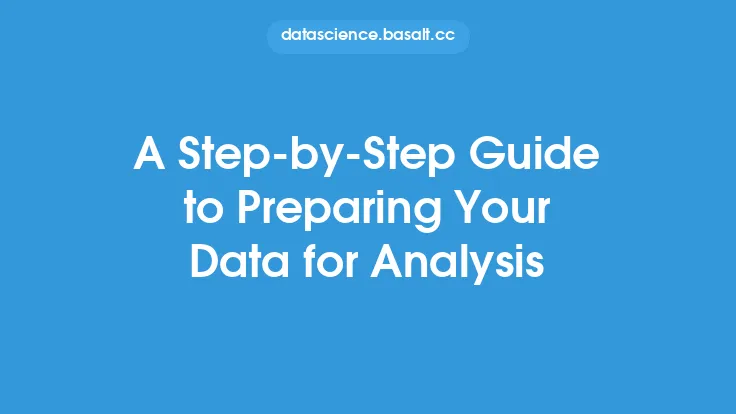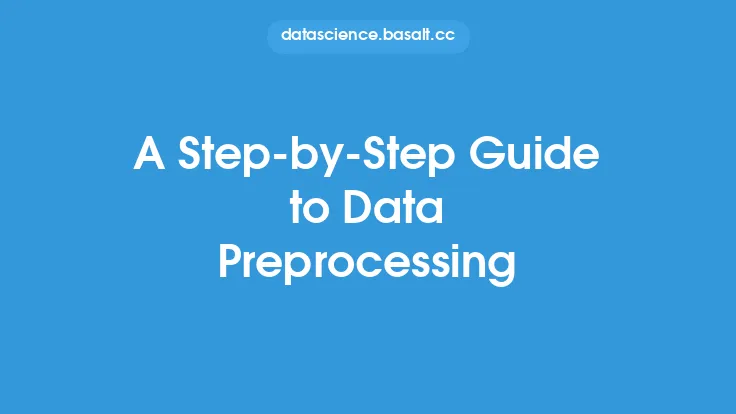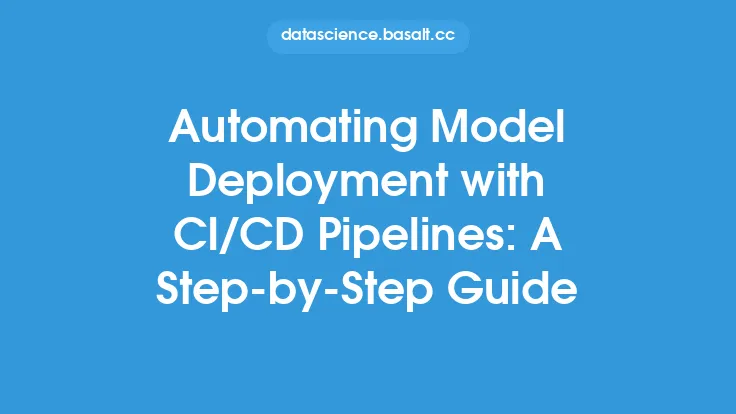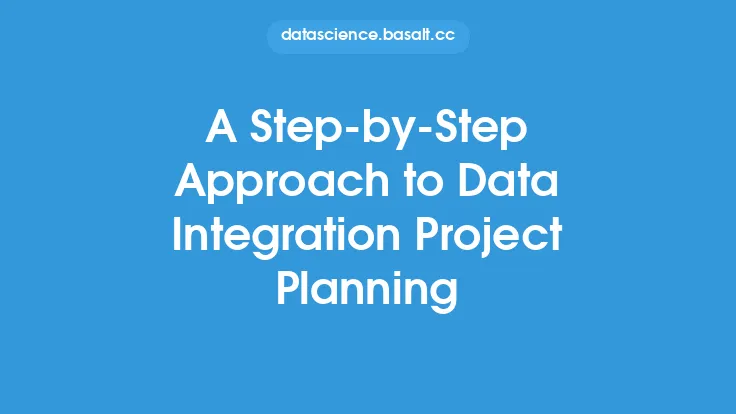Data cleansing is a crucial process in data quality management that involves identifying, correcting, and transforming inaccurate, incomplete, or inconsistent data into a more reliable and usable format. The goal of data cleansing is to ensure that the data is accurate, complete, and consistent, which is essential for making informed business decisions, improving data analysis, and enhancing data-driven decision making. In this article, we will provide a step-by-step guide to data cleansing, highlighting the key steps involved in the process, and discussing the importance of data cleansing in improving data quality.
Introduction to Data Cleansing
Data cleansing is a multi-step process that involves several activities, including data profiling, data validation, data correction, and data transformation. The process of data cleansing begins with data profiling, which involves analyzing the data to identify patterns, trends, and anomalies. This step helps to identify areas where the data may be inaccurate, incomplete, or inconsistent. The next step is data validation, which involves checking the data against a set of predefined rules and constraints to ensure that it is accurate and consistent. Data correction involves making changes to the data to correct errors, fill in missing values, and transform the data into a more usable format. Finally, data transformation involves converting the data into a format that is suitable for analysis and reporting.
Data Profiling
Data profiling is the first step in the data cleansing process. It involves analyzing the data to identify patterns, trends, and anomalies. This step helps to identify areas where the data may be inaccurate, incomplete, or inconsistent. Data profiling can be performed using various techniques, including statistical analysis, data visualization, and data mining. Statistical analysis involves using statistical methods to identify patterns and trends in the data. Data visualization involves using graphical techniques to represent the data in a way that is easy to understand. Data mining involves using algorithms to identify relationships and patterns in the data. The goal of data profiling is to identify areas where the data may be inaccurate, incomplete, or inconsistent, and to develop a plan to correct these issues.
Data Validation
Data validation is the next step in the data cleansing process. It involves checking the data against a set of predefined rules and constraints to ensure that it is accurate and consistent. Data validation can be performed using various techniques, including data type checking, range checking, and format checking. Data type checking involves checking the data to ensure that it is of the correct data type. Range checking involves checking the data to ensure that it falls within a specified range. Format checking involves checking the data to ensure that it is in the correct format. The goal of data validation is to ensure that the data is accurate and consistent, and to identify areas where the data may be inaccurate or inconsistent.
Data Correction
Data correction is the next step in the data cleansing process. It involves making changes to the data to correct errors, fill in missing values, and transform the data into a more usable format. Data correction can be performed using various techniques, including data imputation, data interpolation, and data transformation. Data imputation involves filling in missing values with estimated values. Data interpolation involves estimating missing values based on surrounding values. Data transformation involves converting the data into a more usable format. The goal of data correction is to correct errors, fill in missing values, and transform the data into a more usable format.
Data Transformation
Data transformation is the final step in the data cleansing process. It involves converting the data into a format that is suitable for analysis and reporting. Data transformation can be performed using various techniques, including data aggregation, data grouping, and data pivoting. Data aggregation involves combining data from multiple sources into a single dataset. Data grouping involves grouping data into categories based on common characteristics. Data pivoting involves rotating data from a row-based format to a column-based format. The goal of data transformation is to convert the data into a format that is suitable for analysis and reporting.
Tools and Techniques for Data Cleansing
There are several tools and techniques available for data cleansing, including data cleansing software, data profiling tools, and data validation tools. Data cleansing software provides a range of features and functions for data cleansing, including data profiling, data validation, data correction, and data transformation. Data profiling tools provide features and functions for analyzing and understanding the data, including statistical analysis, data visualization, and data mining. Data validation tools provide features and functions for checking the data against a set of predefined rules and constraints, including data type checking, range checking, and format checking. Some popular data cleansing tools include Excel, SQL, and data cleansing software such as Trifacta, Talend, and OpenRefine.
Best Practices for Data Cleansing
There are several best practices for data cleansing, including developing a data cleansing plan, using data profiling and data validation techniques, and documenting the data cleansing process. Developing a data cleansing plan involves identifying the goals and objectives of the data cleansing process, and developing a plan to achieve these goals. Using data profiling and data validation techniques involves using statistical analysis, data visualization, and data mining to identify patterns and trends in the data, and checking the data against a set of predefined rules and constraints. Documenting the data cleansing process involves keeping a record of the steps involved in the data cleansing process, including the data profiling, data validation, data correction, and data transformation steps. This helps to ensure that the data cleansing process is transparent, repeatable, and auditable.
Common Challenges in Data Cleansing
There are several common challenges in data cleansing, including handling missing data, handling duplicate data, and handling inconsistent data. Handling missing data involves filling in missing values with estimated values, or using data imputation techniques to estimate missing values. Handling duplicate data involves removing duplicate records, or using data deduplication techniques to remove duplicate values. Handling inconsistent data involves using data validation techniques to check the data against a set of predefined rules and constraints, and using data transformation techniques to convert the data into a more consistent format. Other common challenges in data cleansing include handling data from multiple sources, handling large datasets, and handling complex data formats.
Conclusion
Data cleansing is a crucial process in data quality management that involves identifying, correcting, and transforming inaccurate, incomplete, or inconsistent data into a more reliable and usable format. The process of data cleansing involves several steps, including data profiling, data validation, data correction, and data transformation. There are several tools and techniques available for data cleansing, including data cleansing software, data profiling tools, and data validation tools. Best practices for data cleansing include developing a data cleansing plan, using data profiling and data validation techniques, and documenting the data cleansing process. Common challenges in data cleansing include handling missing data, handling duplicate data, and handling inconsistent data. By following these best practices and using the right tools and techniques, organizations can improve the quality of their data, and make better-informed business decisions.





